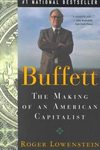Book Review: Buffett, The Making of an American Capitalist
 Buffett, The Making of an American Capitalist, like most biographies, follows the progression of Warren Buffett's career, wealth, and personal life. However, at the same time, author Roger Lowenstein is able to report on the progress of the stock market and many major businesses throughout the text. Because Buffett has been a successful investor for over four decades, the author describes the prospects for success of such organizations as Coca-Cola, GEICO, and the Washington Post. Overall, the book remains engaging while being somewhat lengthy. Lowenstein gives an excellent blend of personal and business information about Buffett that the reader can gain of full understanding of the man.
Buffett, The Making of an American Capitalist, like most biographies, follows the progression of Warren Buffett's career, wealth, and personal life. However, at the same time, author Roger Lowenstein is able to report on the progress of the stock market and many major businesses throughout the text. Because Buffett has been a successful investor for over four decades, the author describes the prospects for success of such organizations as Coca-Cola, GEICO, and the Washington Post. Overall, the book remains engaging while being somewhat lengthy. Lowenstein gives an excellent blend of personal and business information about Buffett that the reader can gain of full understanding of the man.Not having followed Buffett closely in the past, I was aware of his wealth and primary position with Berkshire Hathaway but surprised about five things in particular...
1. He is reluctant to change. My opinion on change, as you can tell from the title of my blog, is that it is unavoidable and somewhat exciting. Buffett, on the other hand, did everything he could to avoid change. As a teen he stayed in Omaha while the rest of his parents and siblings moved to Washington, D.C. He chose to live in Omaha as an adult even though he made his career primarily in New York City. Buffett's desire to remain in Omaha, eat the same foods, befriend the same people, and much more did not allow him to experience a lot of what I consider the pleasures of life.
2. He follows his convictions to a fault. In business, Buffett strictly adhered to his convictions on investing. I respect that. On the other hand, he is a distant father because of his overwhelming sense of responsibility to shareholders. He has a marriage that resulted in separate lives because of his determination to not lose money. He won't help his children financially because he wants to make sure that he will get a return on his investment.
3. He has been interested in making money since his youth. Buffett once stated to a friends' mother (who lived on a busy street), its too bad you can't charge a toll to everyone who drives by your house. It is and always was about making money.
4. Buffett's relationship with family was hurt by his career. Susie Buffett, Warren's wife, moved to California after all of their children were grown. He stayed in Omaha. At his wife's prompting, another woman moved in with Warren. Warren refused to help his sister get out of some financial trouble because she had done it to herself, but at the same time he was not willing to give advice. His youngest son bought him a book about fatherhood and Buffett didn't understand why it was given to him.
5. His investment skills may be the greatest of all time. Buffett had an amazing ability to select stocks that were undervalued. He could do this by both evaluating a balance sheet and by evaluating the business as a whole. This is why he is one of the wealthiest men in the world.
While Warren Buffett may be excessively wealthy, earthly powerful, and known around the world, he does not live a life I will strive toward. My impression is that he his is uncomfortable and unfulfilled. However, since the writing of this book, Buffett has continued his business success, mourned the passing of his wife, and become a major contributor to The Bill and Melinda Gates Foundation. The donation of approximately $30 billion (!) may signal some significant changes in his perspective on life. I am also fully aware that there are many parts of his business practices, such as discipline, integrity, and knowledge, that I need to use if I hope to attain a successful career.









